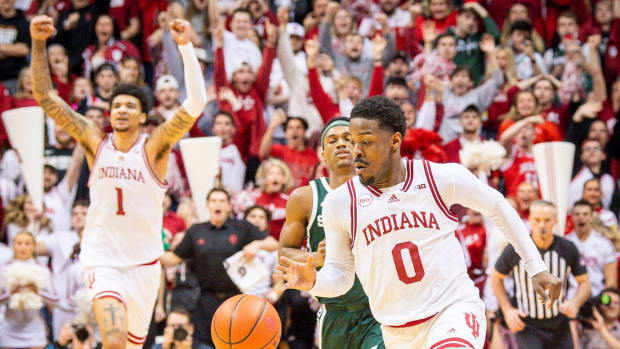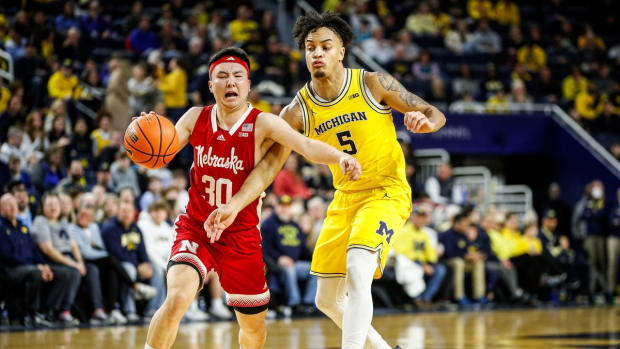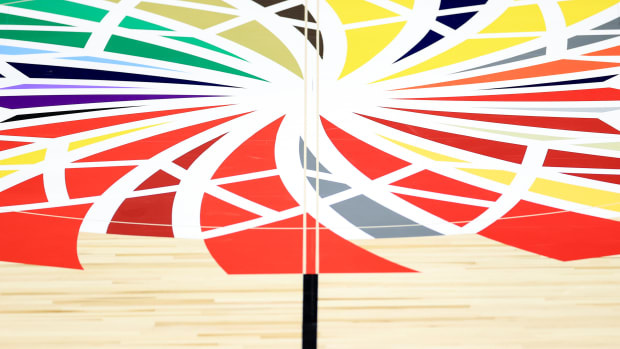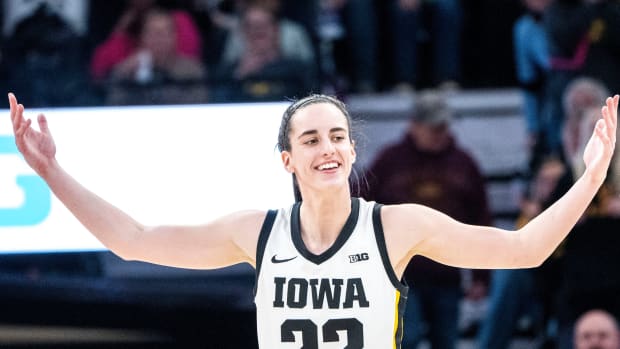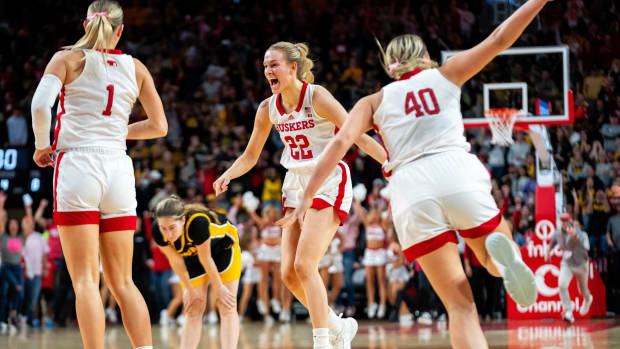Talking Points: Michigan Basketball Pre- & Post-Op Of Low Post Problems in Champaign
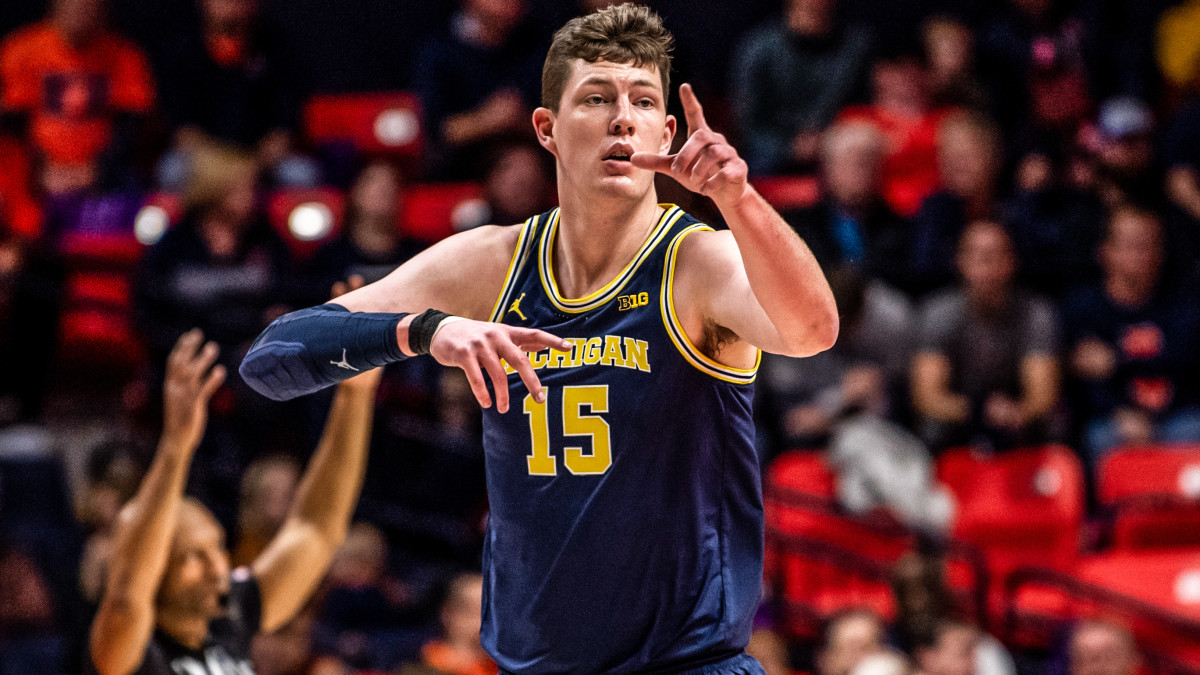
After being gouged for a combined 78 points in the paint in its two previous games, No. 5 Michigan was set to face yet another talented front court in its tilt against an Illinois team led by freshman center Kofi Cockburn. Although young and not as skilled of a player as Iowa junior center Luka Garza, who dropped 44 on the Wolverines earlier in the week, Cockburn is a force in the low post that entered the contest averaging 15.4 points, 10.7 rebounds and 1.1 blocks per game.
“Strong, tough, physical inside presence,” Michigan head coach Juwan Howard said of the Jamaican rookie. “Plays extremely hard, very good on the low block. Another thing that stands out is—excellent offensive rebounder. Built with a lot of toughness. We have to match toughness.
“Our guys are very competitive, they’re not afraid. They love competing against any big that steps on the floor.”
In addition to Cockburn, the Illini offered another talented big man to compete against in sophomore forward Giorgi Bezhanishvili, who entered Wednesday’s matchup scoring 9.8 points and 5.4 rebounds per contest. As a team, UI led the country with a 42.8 Offensive Rebound Percentage (OR%) and 4.8 Block Percentage (Blk%) according to KenPom advanced statistics. UI improved upon all of the aforementioned numbers with a dominating low post performance in its 71-62 win over U-M.
The Wolverines may have loved competing against the Illinois bigs, but certainly did not love the result. Cockburn was the best player on the court, pacing all participants with 19 points, 10 rebounds, six offensive rebounds and four blocks. Bezhanishvili added 12 points, eight boards and a rejection of his own.
As a team, the Illini bludgeoned Michigan for 44 points in the paint and snatched 15 offensive rebounds that led to 16 second-chance points. U-M yielded 14 layups or dunks, which proved absolutely vital for an ice-cold shooting UI team that hit just 14 of 43 jumpshots (32.6 percent).
For those keeping track, that’s 122 points in the paint yielded by the Maize and Blue in its last three contests (40.7 points per game), and 100 in its last two (50.0 points per game). In its last two games, Howard’s squad has surrendered 15 offensive rebounds apiece that have resulted in an average of 21.5 second-chance points per game.
Howard’s team managed a decent 26 points in the paint, but did not score any second chance points. A combined 34-point differential low post and second-chance scoring is problematic on its own, but even more difficult to overcome in a hostile environment and on a frigid three-point shooting night in which Michigan was just 3 of 18 from beyond the arc (16.7 percent). It was a similar, yet more severe, quandary that the Wolverines found themselves during their loss to Louisville, in which they were outscored by a combined 14 points in these two areas and shot a paltry 15.7 percent from deep.
While senior center Jon Teske is a force on both ends of the court, U-M has not yet shown that it has the depth behind him to handle teams that hit the offensive glass hard with taller post players that possess either elite skill or toughness. Freshman Franz Wagner and sophomore Brandon Johns have both shown glimpses of skill, motor and energy at the power forward spot, but their size can be an issue when tasked to guard taller players. Sophomore center Colin Castleton came into the season with high hopes, but hasn’t seen more than nine minutes in any of the last five contests. Fifth-year senior center Austin Davis provided 10 solid minutes against Iowa, but has only seen action in four games this season.
The Wolverines currently rank 13th in the Big Ten in both OR% (24.1, 280th nationally) and DR% (28.8, 196th nationally). Four conference teams rank in the top 25 in the country in OR%, and six in the top 50. Michigan will continue to see teams with talented bigs determined to clean up the offensive glass, and will have to figure out a way to mitigate their struggles in the paint moving forward.
Here is a look at two more notable quotes by U-M head man Juwan Howard, and how they translated on the court against Illinois.
On what the coaching staff team could learn from the road loss to Louisville, and apply to its matchup with Illinois:
“It’s tough to duplicate how the Louisville atmosphere was. That was great to experience early in the year. It prepares you for moments like what we are about to encounter tomorrow versus Illinois, because the Champaign that I recall is one of the tough places to play in the Big Ten.”
Michigan’s offense was up for the moment initially, tuning out the crowd noise while making six of its first eight shots heading into the first media timeout. Many of the offensive issues that plagued the Wolverines against Louisville were improved upon—U-M assisted on 12 baskets against Illinois as opposed to six against Louisville, turned the ball over only eight times and shot nearly 18 percent better from the field against the Illini.Still, Howard’s squad managed just 61 points, it’s second-lowest scoring output of the season and more than 19 points less than its season average. There was one common denominator in the two losses—dreadful three-point shooting.
Two games is a small sample size, but Michigan has looked like a completely different team shooting from beyond the arc on the road than at home or neutral sites. These road struggles have made apparent just how much the three-ball contributes to the overall effectiveness of the offense.
In Champagne, the Wolverines hit just 3 of 18 shots from deep (16.7 percent), which allowed the UI more freedom to congest the paint and contest interior shots as the game progressed. Over the first 16 minutes of the second half, a critical stretch in which Illinois gradually widened a two-point halftime gap to an ultimately insurmountable 12-point advantage, the U-M made only 2 of 8 layup attempts (25.0 percent) and had four shots blocked. In total, Michigan made just 6 of 15 shots in the paint in the second half (40.0 percent), and attempted only six three-point attempts over the last 20 minutes as opposed to 12 tries in the first-half. With its three-point threat diluted, the Maize and Blue halfcourt offense was often sluggish and lacking the flowing ball movement that helped it score 103 points against Iowa earlier in the week.
While true that all teams can benefit from shooting effectively from three-point range, U-M’s success has been particularly dependent on the deep ball this season. In games in which the Wolverines have shot 35.0 percent or better from downtown, they are 7-0, hitting 60.7 percent of their two-point shots and averaging 87.1 points per game. When making less than 35 percent of their three-point attempts, they are 1-2, shooting 48.3 percent from two-point range and averaging only 58.0 points per contest. In two true road contests, Michigan is shooting just 16.2 percent from deep—all losses by an average of 12.0 points. In eight games at home and neutral sites, the Wolverines have made 42.2 percent of their three-point attempts—all wins with an average victory margin of 17.0.
More on what the team learned from its trip to Louisville, specifically on how to manage an off-shooting night:
“I will say this, we as a group learned that, no matter what, if the ball is not bouncing in for you on the offensive end, continue to play defense on the other side of the floor. I think that is that is what we made strides at.”
A quick look at the game stats shows a solid defensive outing in which Michigan held Illinois to 14 points below their season average on 45.9 percent shooting, forced 13 turnovers, blocked five shots and registered six steals.
U-M struggled to get critical stops in the second half, however, and when it did force missed shots, the Illini were able to turn offensive rebound into second-chance points. Illinois scored 41 points in the second half with 14 coming via high-percentage dunks or layups and 10 points of the second-chance variety. Conversely, Michigan struggled gaining offensive advantages from positive defensive efforts, converting 13 UI turnovers into just five points and scoring only eight points in transition.
In addition to abusing the Wolverines for 44 points in the paint, Illinois bullied its way to 20 free-throw attempts, making 14 (70 percent). Michigan scored just five points from the charity stripe on six tries (83.3 percent).
Are you more concerned with Michigan’s recent issues defending the paint or its road shooting slump? Neither? Comment below!!!

